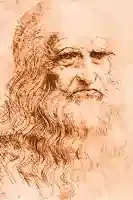Let's Meet Leonardo da Vinci
Leonardo da Vinci was born on April 15, 1452, in the small village of Vinci, in a region of Italy called Tuscany. In his own lifetime and in the present day, da Vinci continues to be universally considered as one of the, if not most, influential thinkers, engineers, mathematicians, scientists, inventors, and painters of all time.
Leonardo has often been described as a man of "unquenchable curiosity" and "feverishly inventive imagination.”
As a child, Leonardo da Vinci showed interest in the visual arts, mainly in the areas of sketching and painting. He began sketching and writing his ideas daily in notebooks. One of the forms of writing that Leonardo, as a young boy, practiced was called mirror writing. He continued to use mirror writing throughout his life in his journals and documents.
Mirror writing only appears normal if
held in front of a mirror. Many of Leonardo’s personal notes and documents have
been found to be mirror writing. There is no evidence as to why he did this.
Some historians believe he used mirror writing like a "secret code,"
trying to keep his inventions private or secret.
Why is Leonardo da Vinci so important?
There are a small number of people who
have changed the world and have changed the way that we look at it. Leonardo da
Vinci is one of those people. He painted some of the most recognizable
paintings that have stood the test of time. Paintings like the Mona Lisa and
sketches of human anatomy opened the door to a whole new world of possibilities
where the imagination was the source of knowledge.
The Mona Lisa is arguably the most
famous painting in the world. Its fame rests, in particular, with the smile. Some
people believe that the mystery is because Leonardo shadowed the corners of the
mouth and eyes.
Did you know it took Leonardo da Vinci
ten years to paint Mona Lisa’s mouth?
Not only was Leonardo one of the
greatest painters of all time, but he was also a master of engineering. Leonardo’s
scientific and technical drawings have captured people’s imaginations for
centuries. Leonardo theorized and invented advanced technology. He was
fascinated by the way things worked and he invented new machines that would test
human limits, in a particular flight. He was, perhaps, the first European
interested in a practical solution to flight. Leonardo designed a series of
mechanical devices, including parachutes, and studied the flight and structure
of birds. Around 1485 he sketched detailed plans for a human-powered
ornithopter (a wing-flapping device intended to fly). There is no evidence that
he actually attempted to build such a device. The notion of a human-powered
mechanical flight device, patterned after birds or bats, recurred again and
again over the next four centuries. One of da Vinci’s most recognizable flying
machines is the one that closely resembles a present-day helicopter.
Leonardo da Vinci’s “Vitruvian Man”
Leonardo da Vinci's understanding of the
human body and mathematics was groundbreaking. Da Vinci's Vitruvian Man is a
set of mathematical rules about the math of the body (such as the fact that arm
span is equal to height). Leonardo saw a kind of mathematical perfection in the
human form. The anatomically correct figure stands within the form of the
circle and the proportions of the square. This is said to be one of the most
iconic drawings in history. Leonardo was a fond enthusiast of the human body and intensely studied mathematics and anatomy. The Vitruvian man is the perfect
example of how math and the proportions of the human body can go hand in hand.
.webp)
In this drawing, he corrected
inconsistencies in Vitruvius’ measurements of the human figure, based on his
own observations and measurements he had collected when studying life models.
Through the precision of his own
measurements, he created an image that is accepted as a true representation of
Vitruvius’ findings and a perfectly realistic image of the ideal proportions
of the human figure. The belief that mathematical law governs everything in the
universe goes back hundreds of years before Leonardo’s birth. All of Leonardo’s
investigations regarding natural phenomena were carried out with a firm belief
in the mathematical principles underlying all forms.
Body Proportions and The Vitruvian Man
In measurement, body proportions are
used to relate two or more measurements based on the body. Here are the
proportions according to Leonardo da Vinci’s Vitruvian Man:
- a palm is the width of four fingers
- a foot is the width of four palms
- the length of a man's foot is one-seventh of his height
- the length of a man's outspread arms (arm span) is equal to his height
- the distance from the hairline to the bottom of the chin is one-tenth of a man's height
- the distance from the top of the head to the bottom of the chin is one-eighth of a man's height
- the distance from the bottom of the neck to the hairline is one-sixth of a man's height
- the maximum width of the shoulders is a quarter of a man's height
- the distance from the middle of the chest to the top of the head is a quarter of a man's height
- the distance from the elbow to the tip of the hand is a quarter of a man's height
- the distance from the elbow to the armpit is one-eighth of a man's height
- the length of the hand is one-tenth of a man's height
- the distance from the bottom of the chin to the nose is one-third of the length of the head
- the distance from the hairline to the eyebrows is one-third of the length of the face
- the length of the ear is one-third the length of the face
For more information, kindly click here


.webp)






0 Comments